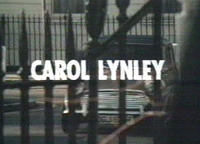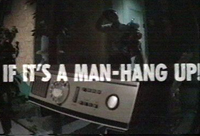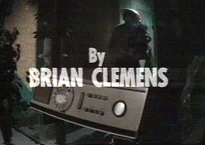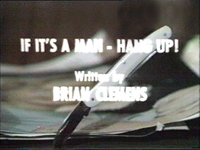MARKETING THRILLER
(Note: The following includes a certain amount of speculation which remains our only way to go as long as production files remain inaccessible.)
In 1973 a US version (aka 71 edit) of each Thriller episode was produced. It was approx. 65 to 70 minutes long (the length required for a 90 minute slot). ABC received these and transferred them (or had them transferred) to NTSC for transmission, sometimes months ahead of the UK transmission of the respective episode. In the UK approx. two minutes worth of footage was edited out of the episodes, to make them fit in the allocated 75-minute-timeslot (although by one account the S1 episodes were identical in the UK and the US).
So we know what the original ATV formats were, but until recently there was a lot of confusion as to what the first US/international versions actually looked like. According to Brian Clemens himself the show was called Menace during its initial US run, and it did have the fish-eye/Johnson theme intact. Calling it Thriller was impossible due to the previous Boris Karloff series of the same title. US TV guides of the era do not seem no mention umbrella titles (the episodes were listed simply as 'movie').
Memphis-based Mark Faulkner disclosed the following info to http://thriller.shorturl.com/ a while ago. It is the most detailed (and hence most credible) account to date:
"ABC's Wide World of Entertainment debuted on January 1, 1973, and ran through September 5, 1975. ABC had been searching for a format to topple NBC's venerable Tonight Show starring Johnny Carson to no avail. Having tried numerous talk shows, the network finally settled on a series of various genre programs: made-for-tv mysteries, a discussion series with Dick Cavett, one-off specials, and a variety series from Dick Clark entitled In Concert. (...) Initially those films were all broadcast as ABC's Wide World of Mystery. The Wide World of Entertainment moniker was an umbrella title for all the shows. Each show was listed by genre (ie, the Dick Clark program was ABC's Wide World In Concert. Although the films might have been referred to as ABC Mystery Movie in TV listings, that was not the correct title. In fact, Wide World of Mystery actually had its own signature theme used for the opening sequences, promos, and bumpers. (...) The graphics were very similar to the Movie of the Week, which was very popular at the time. The title font was very similar to the Mary Tyler Moore Show. While the theme played, scenes from that night's presentation would appear in slanted boxes which would move forward toward the viewer in the style of Stanley Kubrick's 2001: A Space Odyssey. [T]he "fisheye credits" were retained, as well as Laurie Johnson's memorable theme. Both of those initially drew me to the series of films. As a youngster, distorted camera angles and discordant music always disturbed me, but I loved every second. As I recall, the American transmissions also retained the "END PART .../BEGIN PART... titles. However, I'm almost certain the features were not divided into three 21 minutes segments. I recall a surfeit of commercials (...). Right before the end of the break, ABC would replay the WWoM promo for that night's presentation, so that if one came into the story late, it would be easy to get an idea of the basic premise. The one thing that I do NOT remember is any reference to the title Menace. (...) I did NOT realize that these films were part of a series. I knew they had a similar format, the same production values, and were all produced by ATV, but I (...) simply assumed that this was a standard practice for the production company (...). Of course, the Thriller films were interspersed with American-produced knock-offs (also recorded on videotape) and other British telefilms. (...) After ABC's Wide World of Entertainment officially ended in September 1975, most of the features presented were the videotaped American mysteries rather than Thriller reruns."
Years later, the episodes were marketed as a new product in the US. ABC used their NTSC masters as the basis for this (this is the only explanation of why all of the credits were readily available to the producers of the new versions). New title sequences, produced by obscure production companies, were shot and inserted. All Thriller episodes were transformed into TV movies, shown alongside other (genuine) TV movies. The umbrella title became ABC Mystery Movie. (Some of these were released on video, see below.)
When repeats in England were to begin some lunatic decided NOT to select any of the earlier versions (some of which might have been wiped by then) for this repeat run. The partially American produced TVMs were chosen instead. The picture quality of the episodes though was so bad (due to them having been poorly converted from PAL to NTSC in the first place and then back to PAL – simple NTSC to PAL conversions are not normally a problem for 1970s technology) that only the title sequences (plus embedded teasers!) were kept. The rest of the episode was EITHER taken from the ATV version OR!! from the original PAL 71 edit– only in those (few) cases where the latter survives (If It's A Man, Hang Up!, In the Steps of a Dead Man and Only A Scream Away are examples). These versions, therefore, should be called PAL TVMs, as opposed to (NTSC) US TVMs.
A close examination of some teasers shows that they were retained in their entirety. Episodes such as Sign It Death (and even relatively poor circulating copies of Dial A Deadly Number, Not Guilty!) show all signs of conversion during their opening minutes. Just compare the picture quality to the rest of the episode (thanks to Barry for bringing that to my attention). TVM credits occasionally appear together with original ATV teasers. To replace these scenes with superimposed titles would have been highly complicated because they would have had to be hand-painted to match the rest and superimposed again. For this reason there cannot be a mixture of PAL and NTSC scenes, and a little rewinding and replaying show they weren't (again, thanks to Barry for this). The title sequences of the PAL TVMs, therefore, were all NTSC conversions.
Two PAL TVMs supply interesting evidence. During the title sequence of Death in Small Doses we hear a second of Laurie Johnson's theme when the old woman screams, realizing she is about to die at Masters' hands. Something similar happens during the embedded teaser of the Come Out PAL TVM and, apparently, in the NTSC copy of Death Policy (although "different" in the latter case). If a chunk of the theme was retained in the title sequence plus embedded teaser then this music must have been a part of the original US screenings.
The original ATV versions were sold to Germany in 1979/1980, and to Denmark and Italy (dates unknown). They were sold to France in the telerecording format, to overcome transfer difficulties (according to Barry they could have been for Australia as well which seems more logical since Australia is a much more important market). Belgium and Holland showed a mixed package of ATV versions and PAL TVMs which proves they bought the series after 1981. Alternatively, they could have bought ATV versions earlier and PAL TVM versions only later.
In the US several NTSC TVMs were released on video. As these are based on the NTSC masters they are longer / have "extra" scenes if you compare them to PAL TVMs from England or Australia. In fact it is mainly due to these routinely traded official releases that we know the early US versions were extended.
In Britain four episodes were released on video in the early 1990s. Three ATV versions were chosen, and one PAL TVM because the ATV version did not seem to be available (for whatever reason).
In 1996 Bravo were the first to show ATV versions again – at least those which were available. ATV episodes not available to Bravo in 1996, though, are not necessarily non-existent. Only a thorough physical search in the Carlton archives and a subsequent update of their databases could clarify this matter once and for all, and according to Ian Kerr this is exactly what is being done right now.
What NTSC formats are held by rights holder A & E in the US is not known. No-one ever made enquiries.
What PAL formats are held by Carlton in the UK is not known either (see above). Ideally they should hold FOUR versions (71 Edit, ATV, TVM, telerecording) of each episode (on any professional format such as D3, 1", 2", U-Matic) – 172 different films! It seems highly unlikely that anyone would take the pains to store all of these. (If you want to know what professional formats look like take a look at the photo gallery on the BBC's treasure hunt pages: http://www.bbc.co.uk/cult/treasurehunt/formats/index.shtml )
Basically only one question remains unanswered. Since extensive crew credits were available to the producers of later versions and the ATV formats only credited the designers (not other crew) up to episode 33, their source must have been the original US version (whose credits, in turn, must have been based on production files).
Especially in later seasons it seems odd to have
a) a 65 minute ATV Thriller displaying 15 [initial seasons: 4] crew credits
b) a 67 minute US Thriller displaying 23 credits, being identical to the former except umbrella title, additional scenes and additional crew (3 Floor/Stage Managers, Vision Mixer, Production Secretary, Production Assistant, Executive Producer).
Nonetheless b) seems to have been reality, and we have to develop a theory on how this came about.
The empirical basis for our considerations is the VHS tape recently provided by Carlton, containing timecoded versions of The Next Victim and the "alternative" version of If It's a Man, Hang Up! (now affectionately known as "Oddball"), intriguingly offered as "UK version" by Carlton (see below).
At the beginning of this tape, copied from a "PAL protection master", we find an introductory slide containing the following information:
Series and episode title, version, list of audio tracks, duration, addition of textless material. It is interesting to note that due to the fact that Spanish has so many speakers worldwide ITC produced a Spanish language soundtrack themselves. This would have been particularly useful for the South American market (except Brazil where of course Portuguese rules supreme).
The ATV format of The Next Victim is called an "international version" on the slide. This seems a little misleading: who knows for what reason Carlton (or rather, in this case, ITC) labels one version "international", another "domestic" or whatever. It is highly doubtful that the company's terminology is identical to that chosen by researchers. So any attempt to clarify that is better left out for the time being. What can be assumed, though, is that Carlton's "International version" is tailored to dubbing countries. Belgium etc. would be happy with a non-international version (without textless material) - they just add their subtitles and the translator's name and leave all English titles intact.
The info on the slide was compiled in 1997 by ITC during the Polygram period, and the question remains, how valuable is it? Firstly, the fact that The Next Victim is called "ep. 4" makes little sense, the only reasonable conclusion being that ITC produced 5 "PAL protection masters" in 1997, for whatever reason. Secondly, this version of The Next Victim is certainly not to be confused with a 71 edit (see above).
As to effects track and textless material, using the effects the episode can be dubbed into another language. Editors in all countries can use the textless material (fisheyes in this case) to create new titles in their respective languages.
This also means AMERICAN editors can leave out the Thriller title and re-arrange the remaining pre-title sequence info. Instead of
Thriller – created by Brian Clemens – starring Carroll Baker TP McKenna etc – in The Next Victim
we would get, for example,
Carroll Baker TP McKenna etc. - in The Next Victim – Written by Brian Clemens – Produced by Ian Fordyce – Directed by James Ormerod
Mere speculation? Actually a little more, and this is where the "Oddball" comes in. Its main credits are similar to the example:
Carol Lynley - Gerald Harper David Gwillim Tom Conti - Executive Producer Cecil Clarke - Producer Ian Fordyce - Director Shaun O'Riordan - If It's a Man - Hang Up! - by Brian Clemens
Clarke, Fordyce and O'Riordan are not credited again at the end.
David Self supports my argument in his bookTelevision Drama: An Introduction:
"[I]n America television drama owes more to the cinema than to any other medium, both for its origins and for its working-methods. Consequently there it is far more usual to think of the director rather than the writer as the 'maker' of the television play."
It is highly likely, therefore, that the US Thriller versions had typical US credits, i.e. executive producer, writer, producer, director were mentioned at the beginning of the programme (cf. American series of the era, eg. The Streets of San Francisco, Owen Marshall, Counselor at Law, and McCloud). "American credits" also were a common practice in British series aimed at the American market (Department S, Jason King, The Persuaders, The New Avengers).
By the same token, whilst it was common for British series to list only key technicians (Upstairs, Downstairs, Public Eye, Van der Valk, to name but a few) at the end of a programme in the US a great number of additional contributors are traditionally credited (examples as above). All that would solve the problem which has been bugging me from the beginning, i.e. distribution of the credits. WITHOUT the slightest change of end title theme and its fisheye stills the credits could have been arranged differently. If we choose The Next Victim as an example we have a GB version with 6 "crew slides". If director, producer, title plus writer (and executive producer) are "moved" to the main credits 3 slides remain. Three others can be created to fill the vacancies, which is just the appropriate space for
a) the three floor/stage managers
b) vision mixer and programme administrator
c) production secretary and assistant
who are never credited on any ATV version!
Whereas this seems to be a satisfactory explanation it remains a mystery for the time being why in 1975 the ATV versions began to list more crew credits in mid-season ...
This is an unofficial and non-commercial website. The rights to Thriller are held by Carlton Television. The sole purpose of this page is to promote the abovementioned series - no copyright infringement is intended. However, should the copyright holders be unhappy with my use of screenshots the material in question will be removed immediately.
<DIV>
<H5><A HREF="../index.html">Main</A></H5>
<H5><A HREF="../film-main.html">Film & TV</A></H5>
<H5><A HREF="../contact.html">Contact</A></H5>
<H5><A HREF="../introtext.html">Introduction</A></H5>
</DIV>





